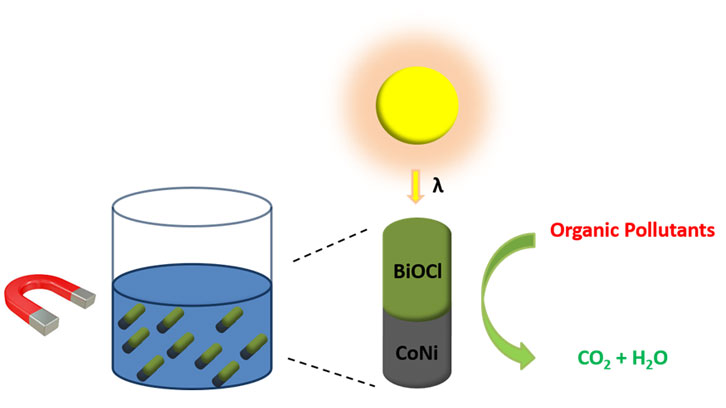Fabrication of magnetic hybrid microrobots for wastewater treatment

Climate change, rapid population growth and crowded cities (and, consequently, the increase in synthetic products consumption) have led to a large number of contaminants in natural water sources and environmental degradation. Currently available water cleaning techniques such as filtration, adsorption and chlorination concentrate and transfer the pollutants to other phases without actually degrading them, and eventually even generate mutagenic/carcinogenic byproducts.
Advanced Oxidation Processes (AOPs) for water purification have recently emerged as alternative smart techniques for modern wastewater treatment. AOPs are based on the generation of highly reactive transitory species for the degradation of organic compounds. Among them, heterogeneous photocatalysis driven by solar light has proven to be a cheap, efficient, and green water remediation technique that completely degrades the pollutants into harmless products like CO2 and H2O. To take advantage of solar energy more efficiently, two semiconducting materials, Bi2O3 and BiOCl, can be combined into a single platform. The synergy between these two compounds may result in a significant enhancement of the photocatalytic activity. Furthermore, to increase the cost effectiveness of this cleaning water procedure, recyclability of the photocatalysts (i.e., reutilization in successive cleaning processes) is highly desirable.
We have recently demonstrated that the aforementioned premises are plausible. In this way, novel photocatalytic micromachines that (i) degrade organic pollutants under UV-visible light and (ii) are magnetically maneuvered, can be prepared using electrodeposition. These microrobots consist of a ferromagnetic cobalt-nickel (CoNi) segment, which allows wireless guiding using external magnetic fields, anchored to a highly porous and photoactive Bi2O3/BiOCl composite segment. The hybrid microrobots can be precisely manipulated (using external magnetic fields) towards specific locations, show excellent photocatalytic properties and are not cytotoxic to cells, and hence are very appealing for their use as cleaning water agents, even in the presence of aquatic life.
Jordi Sort
Eva Pellicer
Department of Physics
Miguel.Guerrero@uab.cat, Jordi.Sort@uab.cat, Eva.Pellicer@uab.cat
References
Mushtaq, Fajer; Guerrero, Miguel; Sakar, Mahmut Selman; Hoop, Marcus; Lindo, André M.; Sort, Jordi; Chen, Xiangzhong; Nelson, Bradley J.; Pellicer, Eva; Pané, Salvador. Magnetically driven Bi2O3/BiOCl-based hybrid microrobots for photocatalytic water remediation. Journal of Materials Chemistry A. 2015, vol. 3, p. 23670-23676. doi: 10.1039/C5TA05825B.


